module 20 Community Ecology
We have explored the factors that determine population size, as well as ways to model or predict how populations will grow or decline. However, the size of a population tells us nothing about what determines the distribution of populations across the planet.
There are two factors that determine whether a species will persist in a location. As we learned in Chapter 5, if a species is able to disperse to an area, its ability to persist there depends on the fundamental niche of that species, which is the range of abiotic conditions that it can tolerate. The survival of a species in a habitat is also determined by the set of interactions that it has with other species. In this module we will explore these relationships.
Learning Objectives
After reading this module you should be able to
identify species interactions that cause negative effects on one or both species.
discuss species interactions that cause neutral or positive effects on both species.
explain the role of keystone species.
Some species interactions cause negative effects on one or both of the species
Community ecology The study of interactions between species.
Symbiotic relationship The relationship between two species that live in close association with each other.
The science of community ecology is the study of interactions among species. Some interactions have negative effects on one or both species. Other interactions involve neutral or positive effects on the two species. As we will see, throughout the world species have symbiotic relationships, which means that the two species are living in close association with each other.
Some of the best-
Competition
Competition The struggle of individuals to obtain a shared limiting resource.
Competitive exclusion principle The principle stating that two species competing for the same limiting resource cannot coexist.
In 1934, two years after his experiments on logistic growth in populations of Paramecium, Georgii Gause studied how different Paramecium species affected each other’s population growth. FIGURE 20.1 shows the results of his experiments. When the two species—

We see competition at work throughout nature. For example, many plant species influence the distribution and abundance of other plant species. Goldenrods are dominant in the old fields of New England because of their superior competitive ability: They can grow taller than other wildflowers and obtain more of the available sunlight. Similarly, the wild oat plant (Avena fatua) can outcompete crop plants on the Great Plains of North America because its seeds ripen earlier, permitting oat seedlings to start growing before the other species.
Resource partitioning When two species divide a resource based on differences in their behavior or morphology.

Competition for a limiting resource can lead to resource partitioning, in which two species divide a resource based on differences in their behavior or morphology. In evolutionary terms, when competition reduces the ability of individuals to survive and reproduce, natural selection will favor individuals that overlap less with other species in the resources they use. FIGURE 20.2 shows how this process works. Let’s imagine two species of birds that eat seeds of different sizes. In species 1, represented by blue, some individuals eat small seeds and others eat medium seeds. In species 2, represented by yellow, some individuals eat medium seeds and others eat large seeds. As a result, some individuals of both species compete for medium seeds. This overlap is represented by green. If species 1 is the better competitor for medium seeds, then individuals of species 2 that compete for medium seeds will have poor survival and reproduction. After several generations, species 2 will evolve to contain fewer individuals that feed on medium seeds. This process of resource partitioning reduces competition between the two species.
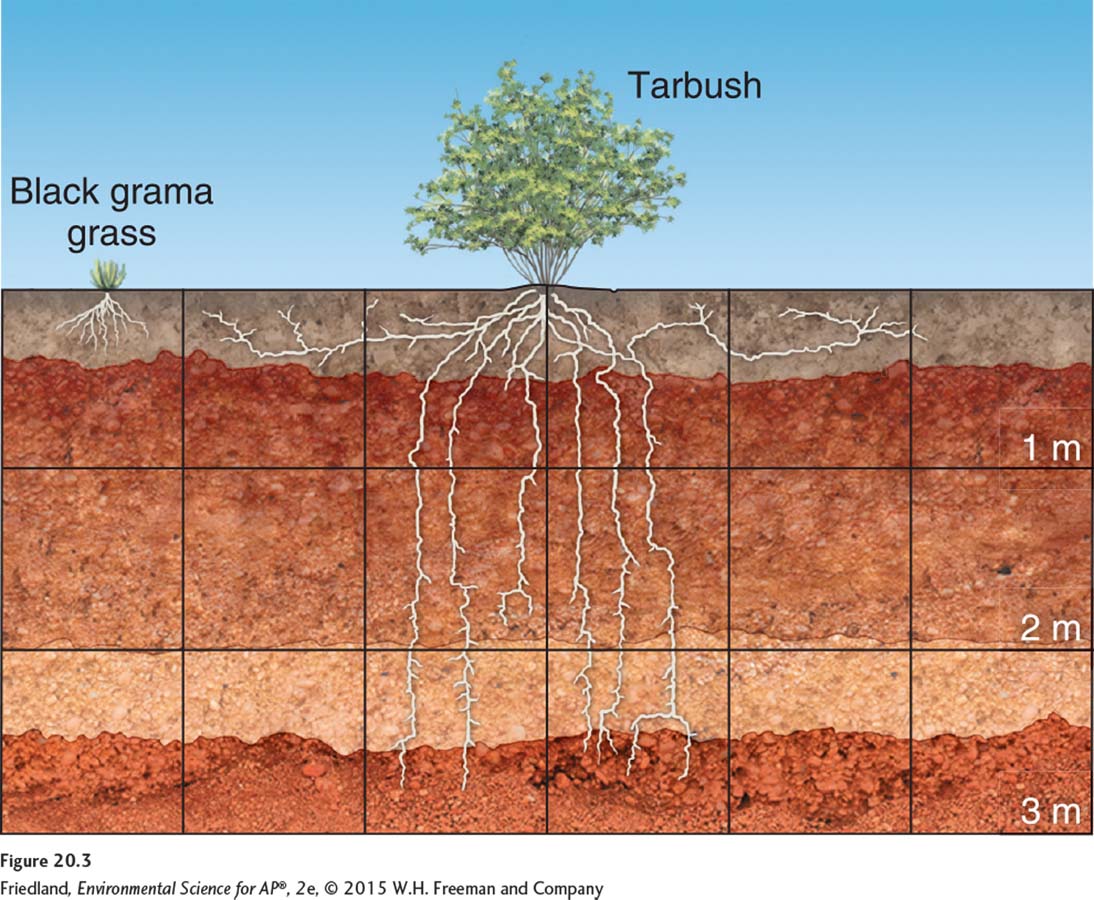
Species in nature reduce resource overlap in several ways. One strategy is temporal resource partitioning, a process in which two species utilize the same resource but at different times. For example, wolves and coyotes that live in the same territory are active at different times of day to reduce the overlap in the times that they are hunting. Similarly, some plants reduce competition for pollinators by flowering at different times of the year.
If two species reduce competition by using different habitats, they are exhibiting spatial resource partitioning. As shown in FIGURE 20.3, desert plant species have evolved a variety of different root systems that reduce competition for water and soil nutrients; some have very deep roots while others have shallow roots. For example, we see that black grama grass (Bouteloua eriopoda) has shallow roots that extend over a large area to capture rainwater, whereas tarbush (Flourensia cernua) sends roots deep into the ground to tap deep sources of water.
A third method of reducing resource overlap is by morphological resource partitioning, which is the evolution of differences in body size or shape. As we saw in Chapter 5, Charles Darwin observed morphological resource partitioning among the finches of the Galápagos Islands (see FIGURE 16.2 on page 166). The 14 species of finches on the islands descended from a single finch species that colonized the islands from mainland South America. This ancestral finch species would have consumed seeds on the ground. Over time, however, the finches have evolved into 14 species with uniquely shaped beaks that allow each species to eat different foods. The beaks of some species are well suited for crushing seeds, whereas the beaks of others are better suited for catching insects. This morphological resource partitioning reduces competition among the finch species.
Predation
Predation An interaction in which one animal typically kills and consumes another animal.
One of the most dramatic species interactions occurs between predators and their prey. Predation is an interaction in which one animal typically kills and consumes another animal. Predators include African lions (Panthera leo) that eat gazelles and great horned owls (Bubo virginianus) that eat small rodents. Organisms of all sizes may be predators, and their effects on their prey vary widely.
Parasitoid A specialized type of predator that lays eggs inside other organisms—
One specialized type of predator is the group known as parasitoids, which are animals that lay eggs inside other organisms—
As we learned from the lynx-
To avoid being eaten or harmed by predators, many prey species have evolved defenses. These defenses may be behavioral, morphological, or chemical, or may simply mimic another species’ defense. FIGURE 20.4 shows several examples of antipredator defenses. Animal prey commonly use behavioral defenses, such as hiding and reduced movement, so as to attract less attention from predators. Other prey species have evolved impressive morphological defenses, including camouflage to help them hide from predators and spines to help deter predators. For example, flounders are a group of fish that lay on the ocean floor with a body color that blends in with their surroundings. Many plants, for example, have evolved spines that deter herbivores from grazing on their leaves and fruits. Similarly, many animals, such as porcupines, stingrays, and puffer fish, have spines that deter predator attack.
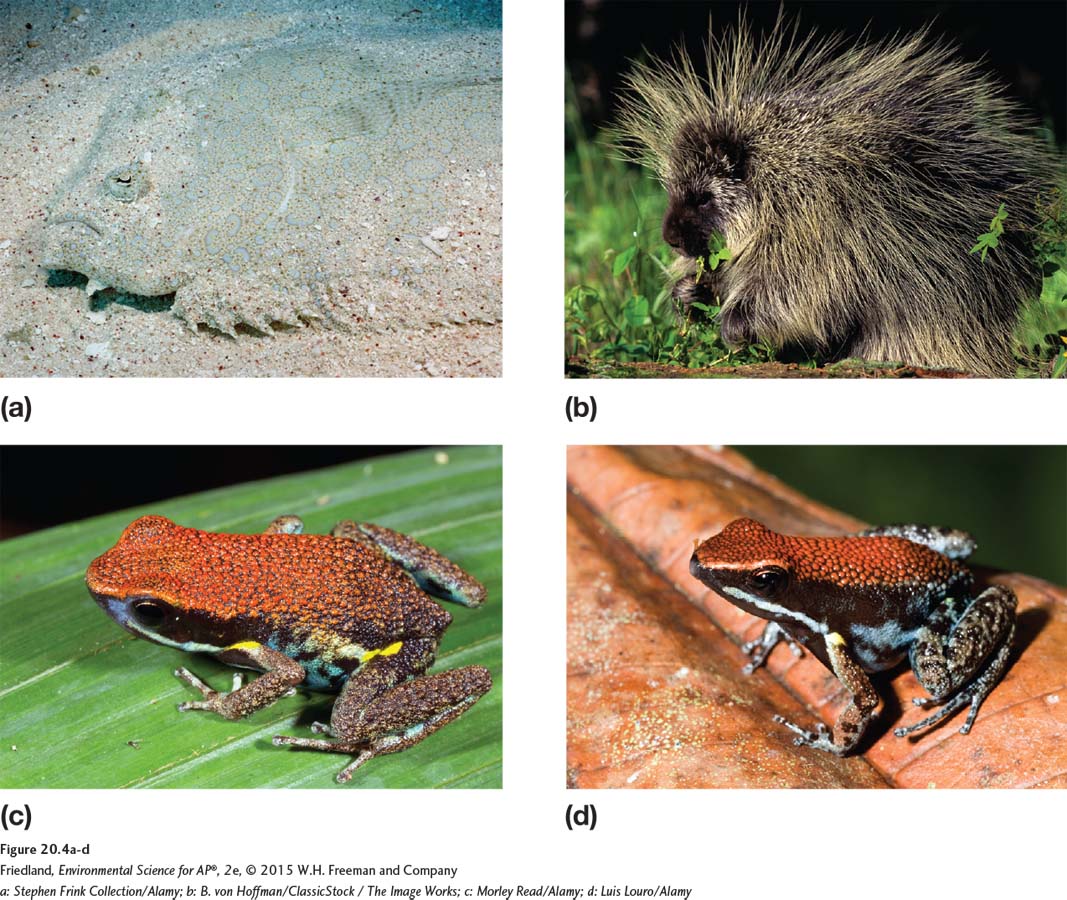
Chemical defenses are another common mechanism of protection from predators. Several species of insects, frogs, and plants emit chemicals that are toxic or distasteful to their predators. For example, the poison dart frog shown in FIGURE 20.4 produces a toxin on its skin that is toxic to many species of predators. Many toxic prey are also brightly colored, and predators learn to recognize and avoid consuming them. In some cases, prey have not evolved toxic defenses of their own, but instead have evolved to mimic the physical characteristics of other prey species that do possess chemical defenses. By mimicking toxic species, these nontoxic species can fool predators into not attacking them.
Parasitism
Parasitism An interaction in which one organism lives on or in another organism.
Parasitism is an interaction in which one organism lives on or in another organism—
Pathogen A parasite that causes disease in its host.
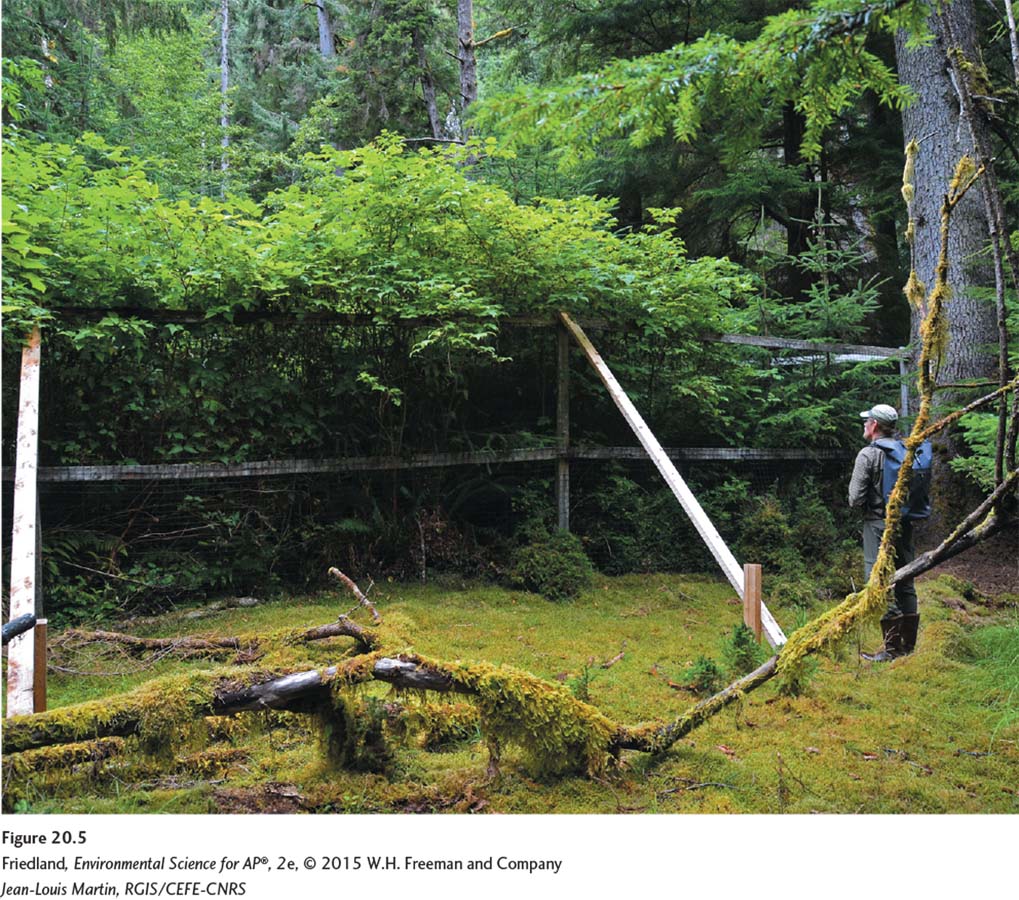
Parasites that cause disease in their host are called pathogens. Pathogens include viruses, bacteria, fungi, protists, and wormlike organisms called helminths. These organisms cause many of the most well-
Herbivory
Herbivory An interaction in which an animal consumes a producer.
Herbivory is an interaction in which an animal consumes a producer. They typically eat only a portion of a producer without killing it. The gazelles of the African plains are well-
Other species interactions cause neutral or positive effects on one or both species
Some species interactions can be quite beneficial to the participants. In this section, we will example two such positive interactions: mutualisms and commensalisms.
Mutualisms
One of the most ecologically important interactions is the relationship between plants and their pollinators, which include birds, bats, and insects. The plants depend on the pollinators for their reproduction, and the pollinators depend on the plants for food. In some cases, one pollinator species might visit many species of plants, while in others, a range of pollinator species may visit many plant species. In still other cases, one animal species pollinates only one plant species, and that plant is pollinated only by that animal species. For example, there are about 900 species of fig trees, and almost every one is pollinated by a particular species of fig wasp.
Mutualism An interaction between two species that increases the chances of survival or reproduction for both species.
When two interacting species benefit each other by increasing both species’ chances of survival or reproduction, we call it a mutualism. Each species in a mutualistic interaction is ultimately assisting the other species in order to benefit itself. If the benefit is too small, the interaction will no longer be worth the cost of helping the other species. Under such conditions, natural selection will favor individuals that no longer engage in the mutualistic interaction.
One well-
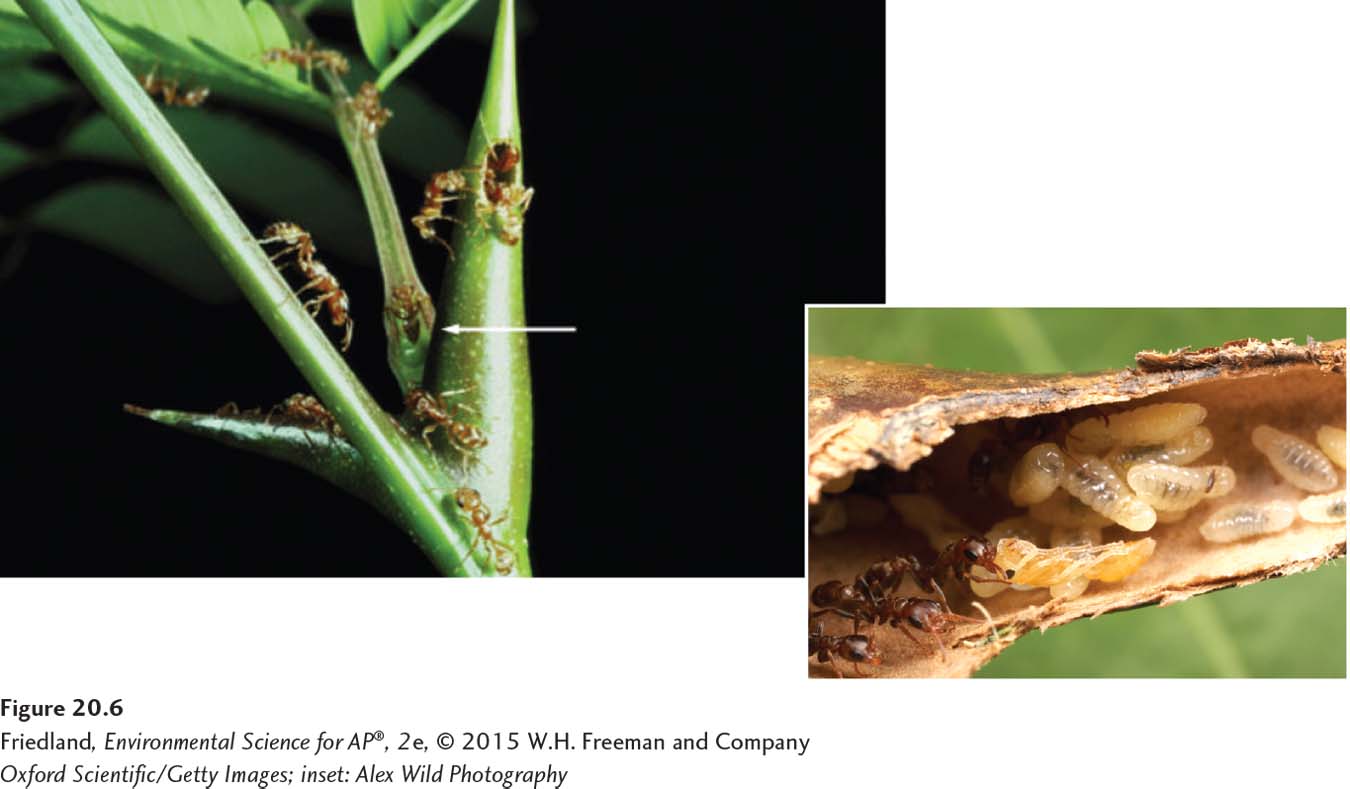
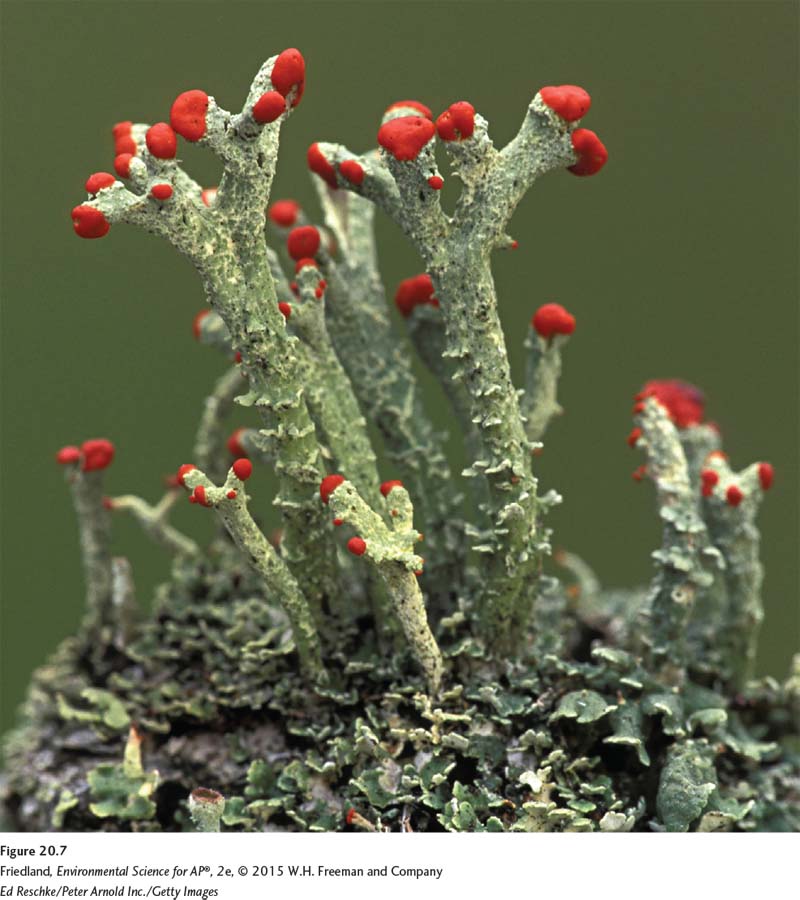
Two other well-
Commensalisms
Commensalism A relationship between species in which one species benefits and the other species is neither harmed nor helped.
Sometimes species can interact in a way that benefits one species but has no effect on the other species. For example, tree branches can serve as perch locations and nest sites for birds. The birds benefit from the presence of the tree because it provides them perches to search for food and a place to raise their offspring. However, the survival and reproduction of the tree is not affected by the presence of the bird. Species interactions in which one species benefits but the other is neither harmed nor helped are called commensalisms. Commensalisms are common in nature. For example, many species of fish use coral reefs as hiding places to avoid predators. The fish receive a major benefit from the presence of the coral, but the species of coral that construct the reefs are typically neither harmed nor benefited by the presence of the fish.
Interactions among species are important in determining which species can live in a community. TABLE 20.1 summarizes these interactions and the effects they have on each of the interacting species, whether positive (+), negative (–), or neutral (0). Competition for a limiting resource has a negative effect on both of the competing species. In contrast, predation, parasitism, and herbivory each has a positive effect on the consumer, but a negative effect on the organism being consumed. Mutualism has positive effects on both interacting species. Commensalism has a positive effect on one species and no effect on the other species.
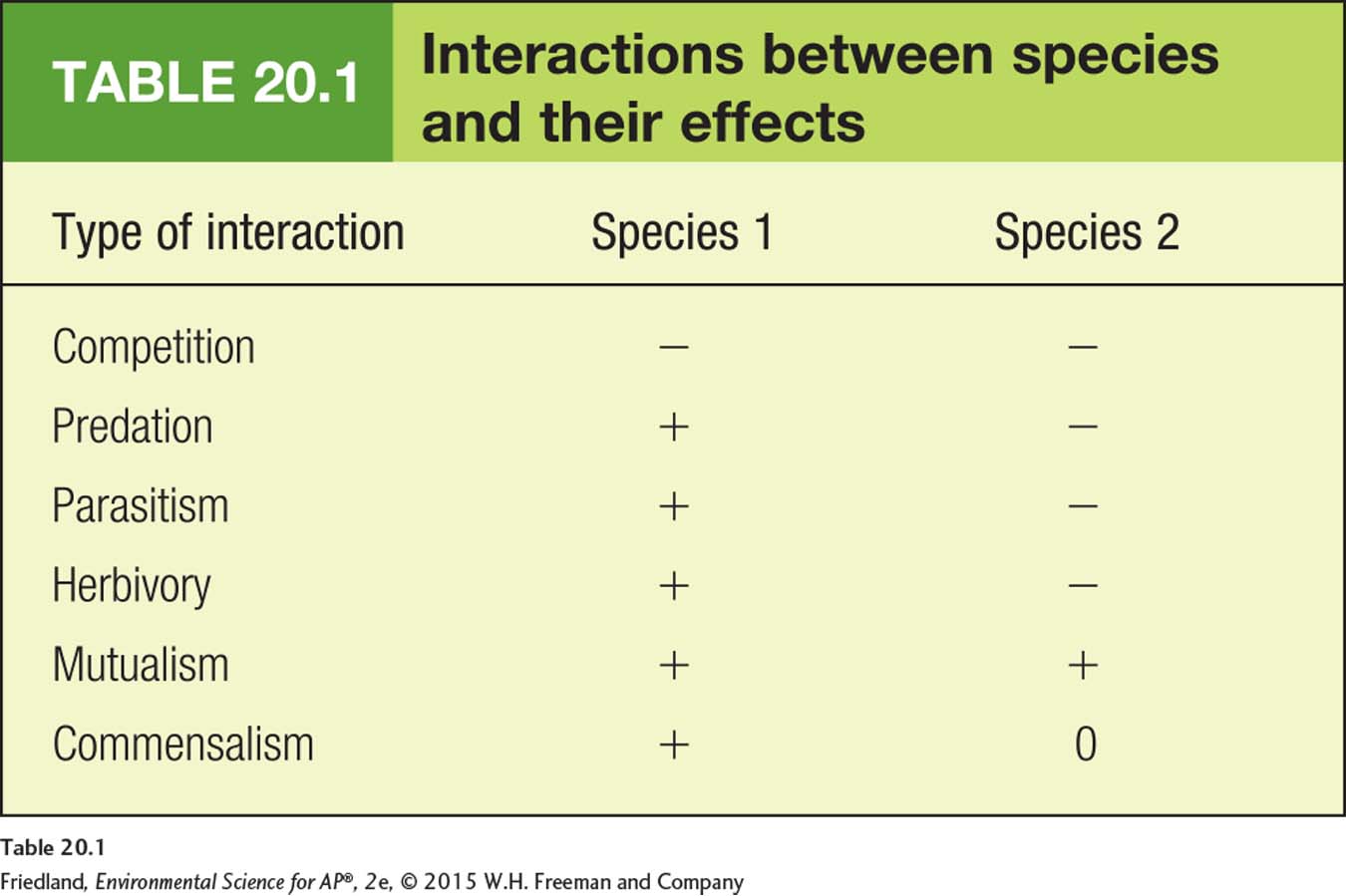
Keystone species have large effects on communities
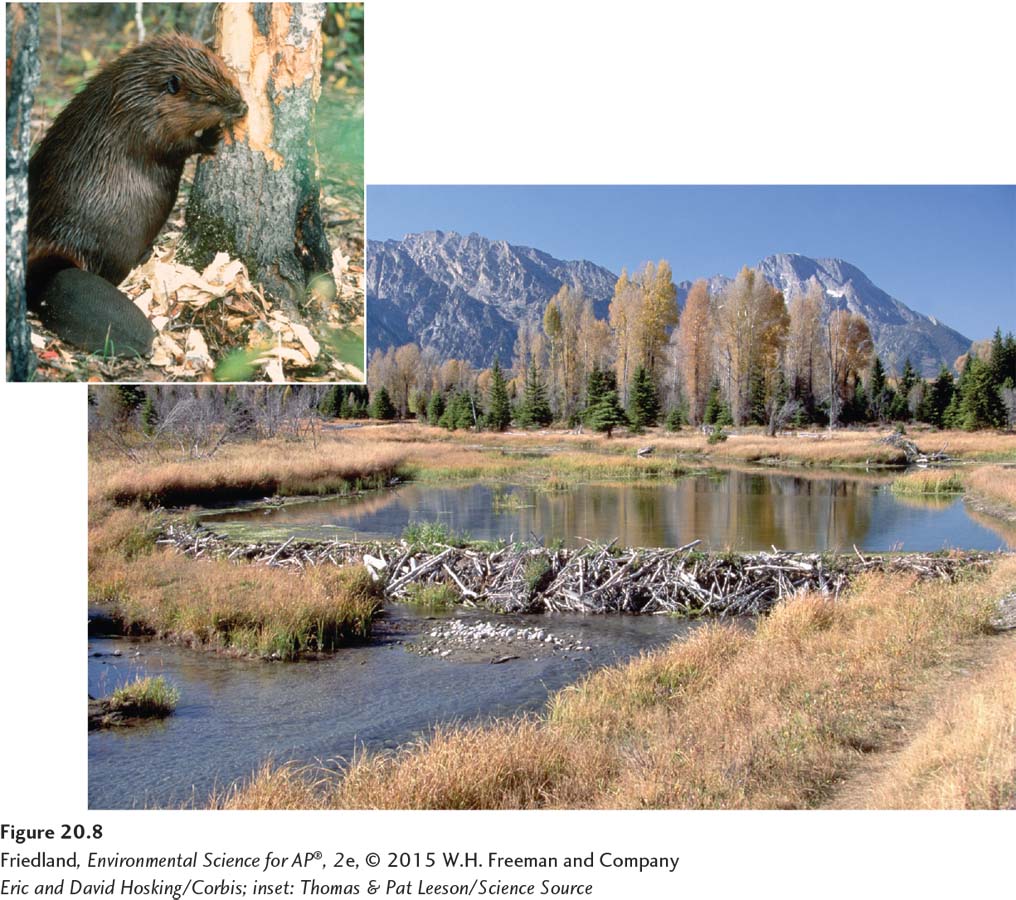
Some species that are not abundant can still have very large effects on a community. The beaver (Castor canadensis) is a prime example. Although they make up only a small percentage of the total biomass of the North American forest, beavers play a critical role in the forest community. They build dams that convert narrow streams into large ponds, thereby creating new habitat for pond-
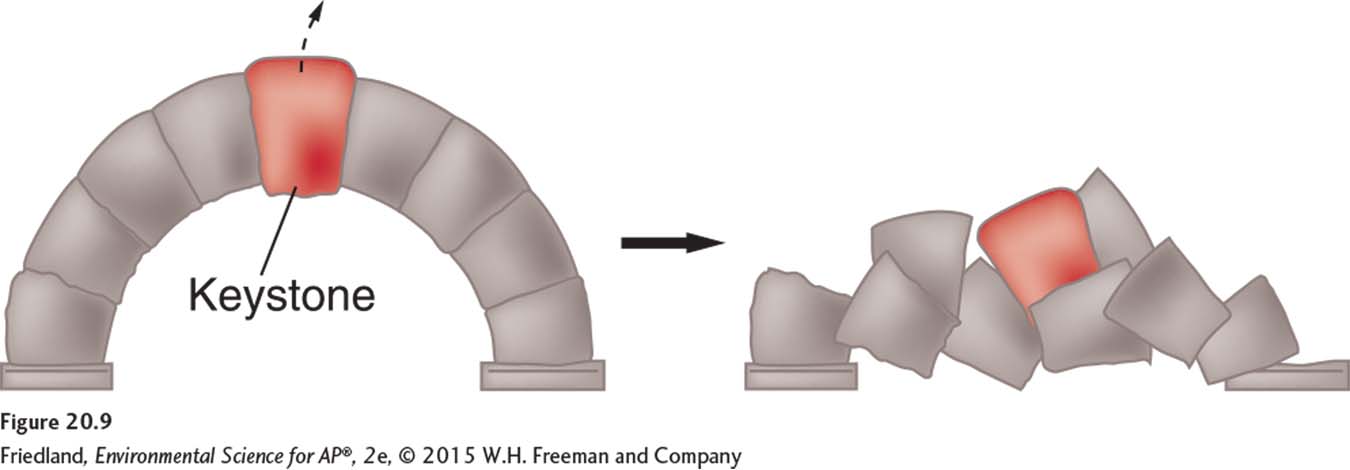
Keystone species A species that plays a far more important in its community than its relative abundance might suggest.
A keystone species plays a far more important role in its community than its relative abundance might suggest. The name keystone species is a metaphor that comes from architecture. As FIGURE 20.9 shows, in a stone arch, the keystone is the single center stone that supports all the other stones. Without the keystone, the arch would collapse. Typically, the most abundant species or the major energy producers, while vital to the health of a community, are not keystone species. Keystone species typically exist in low numbers. They may be predators, sources of food, mutualistic species, or providers of some other essential service.
The role of keystone predators was well demonstrated in a classic experiment conducted in intertidal communities off the coast of Washington State, as shown in FIGURE 20.10. These intertidal communities include mobile animal species such as sea stars and snails as well as dozens of other species that make their living attached to the rocky substratum, including mussels, barnacles, and algae. When sea stars (Pisaster ochraceus) are present, they prey on mussels (Mytilus californianus). This predation continually clears spaces where other species can attach to the rocks. When researchers removed the sea stars from the community, the mussels were no longer subject to predation by sea stars, and they outcompeted the other species in the community. The mussels became numerically dominant, while 25 other species declined in abundance. Thus the predatory sea stars, while not particularly numerous, played a key role in reducing the abundance of a superior competitor—
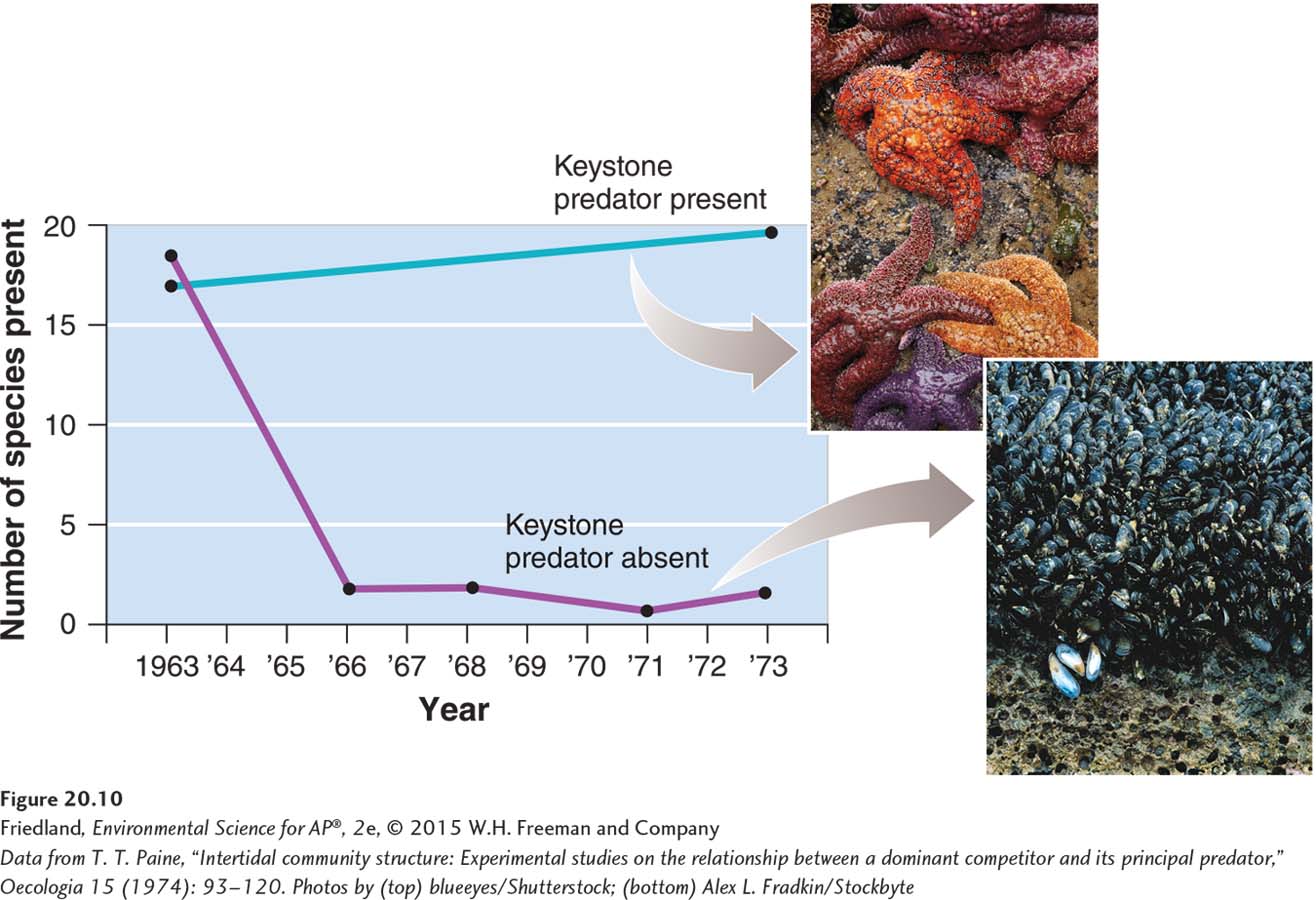
The ability of predators to alter the outcome of competition is common in nature. We observed it in the opening of this chapter, where we described the effects of outbreaks of the leaf beetle that specializes on goldenrods in the old fields of New England. An outbreak of these herbivorous beetles reduces populations of goldenrods, which are superior competitors, and increases the abundance of many wildflower species that are inferior competitors.
Some species are considered keystone species because of the importance of their mutualistic interactions with other species. For example, most animal pollinators are abundant or provide a service that can be duplicated by other species. Some communities, however, rely on relatively rare pollinator species, which are therefore keystone species. On many South Pacific islands, a species of bat known as the flying fox (Pteropus vampyrus) is the only pollinator and seed disperser for hundreds of tropical plant species. Flying foxes have been hunted for food to near-
Mycorrhizal fungi are another group of mutualists that serve as keystone species. These fungi are found on and in the roots of many plant species, where they increase the plants’ ability to extract nutrients from the soil. They play a critical role in the growth of plant species, which in turn provide habitat and resources for other members of a forest or field community.
Ecosystem engineer A keystone species that creates or maintains habitat for other species.
Finally, a keystone species that creates or maintains habitat for other species is known as an ecosystem engineer. We have already seen that beavers are ecosystem engineers. Alligators play a similar role in their communities by digging deep “gator holes” in summer. These holes serve as critical sources of water for many other animals during dry months.